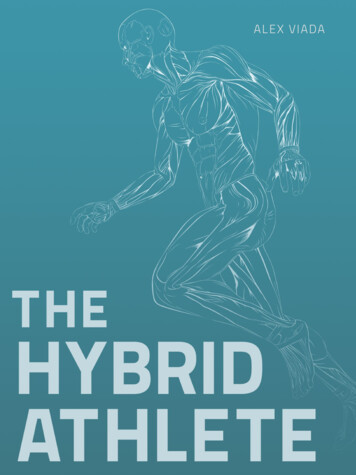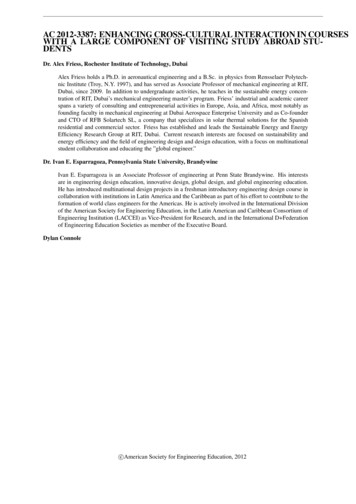
Transcription
ALEX VIADA
THEHYBRIDATHLETEBY ALEX VIADA
THEHYBRIDATHLETEBY ALEX VIADABEFORE YOU PURSUE ANY PHYSICAL FITNESS PROGRAM, ESPECIALLYONE AS INTENSE AS THIS ONE. PLEASE CONSULT A DOCTOR. THISBOOK MAY NOT BE REPRODUCED, TRANSMITTED, OR RECORDED INANY FORM WITHOUT PERMISSION FROM THE AUTHOR.COPYRIGHT 2015 ALEX VIADA & JUGGERNAUT TRAINING SYSTEMS.ALL RIGHTS RESERVED.
TABLE OF CONTENTSINTRODUCTION & HISTORY 11HYBRID TRAINING DEFINED 19NECESSARY PHYSIOLOGY 24MUSCLE STRUCTURE 25MUSCLE STRENGTH 29PHYSIOLOGY OF METABOLISMAND ENERGY SYSTEMS 32GENERAL VERSUS SPECIFICWORK CAPACITY 48CRITICAL COMPONENTS OFSTRENGTH TRAINING 53CRITICAL COMPONENTS OFENDURANCE TRAINING 62CUTTING OUT THE NOISE:ELIMINATING THE WASTE 71SPORT SPECIFIC TRAINING 82THE MILITARY ATHLETE 83THE HYBRID ATHLETE4
FUNCTIONAL FITNESS COMPETITION 92CONDITIONING FOR THESTRENGTH ATHLETE103SPECIAL ENDURANCE FORLARGER ATHLETES112PERFORMANCE CONSIDERATIONS121STRENGTH FOR THEENDURANCE ATHLETE126SPECIAL STRENGTH SPORTCONSIDERATIONS136DESIGNING A PROGRAM149NUTRITIONAL SUPPORT FORHYBRID TRAINING167MACRONUTRIENT REQUIREMENTS175HYDRATION183APPENDIX A — TRAINING PROGRAMS193APPENDIX B — BEER PAIRINGS230APPENDIX B — BIBLIOGRAPHY ANDRECOMMENDED READING236THE HYBRID ATHLETE5
FOREWARDFor many years it has been widely accepted in the athletic and fitnesscommunities that strength and endurance are physiologically opposedto one another and therefore, cannot be simultaneously trained anddeveloped. Strength athletes and bodybuilders believe endurance workweakens them and strips them of their precious muscle mass. Enduranceathletes believe strength work will add unnecessary weight from increasedmuscle and slow them down.I did not grow up in the athletic or fitnesscommunities.I came up in the special operations community where Army SOF, SEALs,Marines and Controllers have been doing both, to some extent, out ofnecessity for decades. It was intuitive and without an in-depth knowledgeof exercise physiology. Endurance is ingrained in our operational mindset.There is no endurance event quite like a 4,000m swim and dive thattransitions into a two day tactical, cross-terrain ruck march with over100lbs of gear. Strength is something on which we pride ourselves.Once on target, we still need to have the strength to physically handleenemy personnel. For decades, we trained with the combination ofstrength and endurance programs we could piece together. Too often thegreatest limiting factor to our success was the ever-present injury due toovertraining.THE HYBRID ATHLETE6
CrossFit hit the stage in the mid-2000s. It initially appeared to be acomplete fix for SOF’s physical training. It was close, especially in the earlydays when the workouts were typically a well-balanced blend of threecategories: strength, lactate, and conditioning workouts. It wasn’t perfect,but it fit. SOF needed strength, short intense workouts, and longer workfor conditioning to cover the physical requirements of the highly variablephysical requirements of the job. We also needed shorter training sessions.At that time, SOF was spending most of its days in either Afghanistan orIraq. Training while deployed was challenging. We did not have time for anhour of weights and an hour or more of running each day.In 2008 I opened CrossFit Wilmington. By that time I had been doingCrossFit-style training for three years and CrossFit was changing rapidly.Olympic weightlifting was becoming the favorite in CrossFit gyms. Theweights in most workouts were getting heavier. It was a logical path.Heavier was the only direction for CrossFit to grow and evolve. As weall know, the heavier we lift, the less volume we can do. The workouts inCrossFit got much shorter. It was at this time that endurance and cardiowork was being greatly demonized by all strength disciplines. The “do youwant to look like a skinny runner” pics and advertisements were all overthe internet. Additionally, some coaches were perpetuating a minimalistapproach to endurance. They were making popular the idea that sprintwork could be translated into endurance. Time would prove there were toomany mistakes in their assumptions, and even more in their application.High intensity interval training (HIIT) training was also gaining popularityat this time. It further added to the misconceptions. The strength worldhad seemingly bought completely into the hype.In retrospect, it seems more that laziness is mostly to blame for theTHE HYBRID ATHLETE7
acceptance of this myth, not fact or science. True endurance work requiresa lot of time and effort. It takes fortitude. the word’s very definitionis to resist or withstand discomfort or pain for long periods of time. Ofall exercise, endurance is certainly the easiest to wish removed from aprogram. My own distances had dwindled from three, five and 10 milesto 400m, 800m and 1 mile sprints. I did a few triathlons during this time.sprint triathlons that is. Since they only take 50-80 minutes to complete,sprint races are not truly endurance events. My program’s link to trueendurance was almost completely severed.Fast forward to 2013. A shoulder injury required I cut out all overheadmovements. By default, I began to work on my deadlift and squat. I’dalways favored and competed in Olympic weightlifting, so I had never triedto develop my 1 rep max deadlift and back squat. My boredom spawneda new goal. I decided to work towards a 1 to 1 ratio between my deadliftand 1 mile run time. I quantified the goal and set it at 550lbs and 5:30.The mention of this goal led to my introduction to Alex. He had, in fact,matched his deadlift and 1.5 mile. Not only that, he was also doing the socalled “impossible”; completing long distance, or true endurance events,while developing max strength. He was doing something right, and Iwanted to know what it was.In the weeks following our introduction, Alex shared with me the lessonshe’d learned. Through both trial and error, and by applying his formaleducation and knowledge of physiology, Alex had realized, not just thatstrength and endurance could be developed concurrently, but actually howto train them. What he shared with me changed the way I programmedmy training. and more importantly, how I programmed my athletes’training.THE HYBRID ATHLETE8
Since applying what Alex shared with me, I was able to nail my 1:1deadlift mile goal. I began at a 485lbs deadlift and a 5:52 mile at 215lbsbodyweight. Four months later I pulled 550 and ran the mile in 5:08 at220lbs bodyweight. The run went better than planned and presented theoption of pursuing the ratio with my squat and mile also. A 515lbs squatgave me that 1:1 ratio as icing on the cake.I made that DL and 1 mile run ratio the “CrossFit Wilmington Challenge.” Ifa member completes it, they get a lifetime membership to my gym. So far,only one has. Kimberly Lawrence, with a 350lbs pull and 6:08 mile (thefemale ratio is slightly scaled per a conversion factor).Since then, I have applied Alex’s methods to bigger endeavors, completinga powerlifting meet and an Iron Distance Triathlon with only two week’sseparation. I hit a 515 squat, 320 bench, and a 525 pull. My race timewas 14 hours, 11 minutes. The most important thing to take away is that Itrained for 7 months for an Ironman and a Powerlifting meet concurrentlyand did not sustain a single injury. My race time was compromisedbecause I fractured the second metatarsal in my left foot at the swim / runtransition. It had little effect on my bike time, but slowed my run by abouttwo hours. Completing the race with a broken foot I partially attribute tothe preparation and training Alex’s methods provided me and partially tobeing harder than I am smart on that type of thing.As a further testament to the methods Alex has pioneered, my athleteshave also pushed the endurance and strength envelop. Melissa Hoff(2013 CrossFit Games competitor) also lifted in the powerlifting meet andcompleted the Iron distance race. I have applied, with great success, thesemethods to my CrossFit athletes’ successes. Not only do my athletes enjoyTHE HYBRID ATHLETE9
a reputation of strength, but any running event is now almost a guaranteedwin. Their recovery between workouts has also improved greatly becauseof the additional aerobic training.Timing the workouts properly has reducedthe risk of injury.My relationship with SOF has taken a different role. I train a large numberof military personnel in preparation for selection/indoc courses for SOFunits. The changes I have made to that training has increased the recoverytimes and improved the overall efficacy of the programming. They entertheir respective selection course more resilient, stronger, faster, andwithout nagging injury. The operational troopers I train enjoy a reducedtraining volume but increased strength and endurance built solely for theirmission requirements. Alex’s methods that I apply to their training keepthem healthy and in a high state of readiness.I hope you are able to apply what you learn from Alex to the same extentI have. This book will undoubtedly further human performance more thanany other in recent years. maybe decades. Enjoy. TONY COWDENOwner CrossFit Wilmington / Wilmington Strength &Conditioning / Competitive EDGE PerformanceTHE HYBRID ATHLETE10
01INTRODUCTION& HISTORY
INTRODUCTION & HISTORYFirst of all, I’d like to extend a genuine thank you to you, the reader, forpicking up this book. I hope you’re even a tenth as excited as I am tofinally have all this information down in one place, and I am thankful for theopportunity to pass along what I’ve learned over the years.As someone who’s deeply passionate about all aspects of fitness andathleticism, but who also recognizes the importance of being well-rounded(both in athletics and in life), I hope you may find something in this textthat changes your approach to training for the better. From the first piecespublished on AtLarge Nutrition and initial seminars at CrossFit Wilmingtonto the various presentations given over the last year, including JTS’ BecomeUnstoppable 3 seminar in California and the joint CHP/TZ Strengthseries in the fall, it’s been great to be able to reach out to such a variety ofathletes, and your feedback (both positive and negative) has shaped mytraining and coaching more than you may realize - so please accept myadditional thanks for that.The Hybrid Training methodology is the product of years and years of trialand error, with a very large emphasis on the error. Given the dearth ofliterature on (successfully) programming for both strength and enduranceconcurrently, it is safe to say that nearly every purported negative ofthe combination has been directly experienced by the author. HybridTHE HYBRID ATHLETE12
Training has now been around, in itscurrent form as we practice it, forapproximately three years, with severalhundred athletes having utilized it intheir sport training, yet it continues toevolve daily.If there is one flat admission to makeregarding this methodology, it isthat this programming “borrows”shamelessly and frequently fromsome of the finest programs outthere, utilizing components fromvarious “conjugate” programs, blockperiodization, daily undulatingperiodization. combining the mostrelevant components of each tocreate a style of programming thatdevelops strength, strength-endurance,sport skill, and aerobic conditioningsimultaneously.The goal of this book is to summarizethis entire system - to give anoverview of how the methodology wasdeveloped, understand the relevantphysiology involved, and allow thereader to design his or her ownprogram specific to his/her needs.THE HYBRID ATHLETE13
I’d like to take a (self indulgent) moment, though, and offer a bit onmy background and how this came about. Though originally from anendurance background (in high school), I got into strength training at theend of college, and made fairly good progress in a short period of time,working up to a top bodyweight of 245 pounds with a 745 pound deadlift.There were still several things I was extremely challenged by, however,including stairs and parking spots too far from the gym. And skippingdessert. Also tying my shoes.Around the time that I was just starting to get accustomed to finding goodspots to rest on the three flights of stairs up to my loft apartment, and hadmastered the whole “two stage two breath shoelace tie” (inhale, exhale,lean down, cross laces, sit up, inhale, exhale, inhale, exhale, lean down,double loop, wrap and tighten, sit up and gasp for air) , I was somehowcajoled into signing up for a 5k - my first real run over 400 meters since Iwas 18. Needless to say, some training was needed, so I gamely attemptedto accompany runners on their training runs and developed an incredibleaptitude for feigning calf cramps and suddenly remembering importantconference calls that I had to go back home to take. Fast forward to therace, and I turned in a mediocre performance, though the post race beerwas outstanding. The beer was too outstanding, actually, since in thatslightly inebriated state I decided to commit to my first marathon - thelogical next step after a 5k.When I started marathon training, I watched my 700 pound deadliftplummet - my recovery just wasn’t there. I lost muscle, I was sore 24/7, Igot stress fractures and shin splints, muscle strains, knee pain and I stillwasn’t a very good runner. Needless to say, mistakes were clearly made,yet the variables seemed to line up - I had a great running program and aTHE HYBRID ATHLETE14
great lifting program, yet nothing came together. A second attempt a yearlater gave me the same results - or lack thereof.The problem was simple - any goodprogram in any sport is designed to pushthe body to near the limits of its recovery- doing enough solid work to maximizethe adaptive response, then allowingjust enough recovery to attack the nextworkout.Combining two programs that push the athlete to 90% and expecting tonot regress may seem to be an obvious no-no, yet it is done all the time,because most athletes still assume there is some dividing line between“strength” training and “endurance” training. The fact is, there is not.Work is work, the principles of physical fatigue, trauma, energy substrateexhaustion, mental fatigue, and adaptive response are absolute, regardlessof the exercise modality, and recognizing this was the first step in creatingsuccessful programming. Being able to break these stimuli and adaptationsdown into discrete components, and train each component in a welldesigned microcycle is where the “magic” came in.THE HYBRID ATHLETE15
Hybrid Training createsa style of programmingthat develops strength,strength-endurance,sport skill, andaerobic conditioningsimultaneously.THE HYBRID ATHLETE 1.016
The magic, of course, is that there IS no magic, just very simpleprogramming principles that are too-often ignored. But perhaps the mostimportant take home message: Work hard, but be lazy. In other words,do as little as possible to attain the necessary result. Lift less often thana powerlifter, run less than a runner, bike less than a cyclist, swim lessthan a swimmer the body has limited recovery, and will quickly becomeoverwhelmed. Isolate what is truly important in each type of training, focuson those areas, and do them well. Cut out the junk miles, cut out the gympissing contests, be draconian in how you approach routines - take thosearticles with the “ten exercises you should be doing” and toss them in thetrash. The more you want to do, the less you should be doing. That is whatHybrid Training, and this book, is all about.What this book is not is a scientific review of the various literaturerevolving around concurrent strength and endurance training. While usefulas a starting point, very little of the literature has provided any usefulconclusions that the author has found regarding this style of programming- as will be discussed later, reductionist/mechanistic approaches have theirplace, but in the arena of complicated, novel programming of a complexorganism in a complex environment, it has its limitations. This is not an“evidence based” book.Quite frankly the lack of evidencebased literature on concurrent trainingfor experienced athletes led to thedevelopment of this entire methodology.THE HYBRID ATHLETE 1.017
Research exists, to be sure, but it is still in an early phase.This book is also not a manuscript being submitted to a peer reviewedjournal. The majority of the information contained can be found in eitherbasic biology texts, or extrapolated from these texts through commonsense. If the reader wishes to view a hundred citations per chapter (whichin most cases you will find, go completely unread even by the author), heor she may wish to look elsewhere - the majority of the statements madeon physiology contained herein can be found in nearly any textbook which is where every individual should start their education in the field ofexercise science. Not on PubMed, not from eBooks (this one excluded - itis fantastic), not from articles, but from the basics.It is remarkable how many questions are answered in the process ofobtaining a basic biology and biomechanics education, and alarming howoften a review of peripherally related, mechanistic/reductionist primaryliterature is being substituted for a basic education in biology. Forgettingthe basics or ignoring the basics is the cardinal sin of exercise science - it isattempting to fine tune a sculpture with a scalpel or nail file while it is still asolid block of wood.THE HYBRID ATHLETE18
02HYBRID TRAININGDEFINED
HYBRID TRAINING DEFINEDHybrid Training is still not easily defined, even though the authortechnically helped popularize the label - the closest definition, wordy asit may be, is that Hybrid Training is “The concurrent training of differentathletic disciplines that do not explicitly support one another, and whosedisparate components are not essential to success at any one sport”.Recognizing the fact that this is a horrible definition, a bit more detailis needed. There are a number of sports which combine strength andendurance- indeed the combination itself is nothing new or novel. Mostany sport falls somewhere in the middle of the pure endurance/purestrength spectrum, though degree varies wildly. Strongman and OLpositions in football are high strength roles that require a certain base levelof endurance and conditioning, while rugby backs or pursuit cyclists requireexcellent endurance, but still need strength and power to win. (Bear inmind, hybrid training principles apply very well to the training of theseathletes, but this is not what makes the principles nor approach unique.)The primary differentiator is that these sports all require this combination- it is not optional. Indeed, peak performance is all about the balance,with each sport having its “ideal” athlete - looking at top decathletes,rugby players, NFL position player, CrossFit games athletes, there’s not atremendous amount of variety in the builds and “performance envelopes”of the top performers.THE HYBRID ATHLETE20
Hybrid athleticism makes no such concessions to “ideal” build - theobjective behind this training is simple - to allow specialists to train allcomponents of athleticism, even ones which they do not appear wellphysically-suited for, without compromising performance in their primarysport. Make no mistake- it is unlikely that a 275 pound pro-totalingPowerlifter will qualify for Boston or run a sub -10 hour Ironman, but thismethodology would still allow this individual to train for and successfullycomplete an Ironman (with performance improvements comparable tomost tri-dedicated programs) while maintaining or improving their total.THE HYBRID ATHLETE21
Hybrid Training is“The concurrenttraining of differentathletic disciplinesthat do not explicitlysupport one another,and whose disparatecomponents are notessential to successat any one sport”.THE HYBRID ATHLETE 1.022
There is, of course, appeal to this methodology beyond the not-so-massivepopulations of Ironman Powerlifters and ultra runners who want to cleanand jerk 1.5 times their bodyweight - these training principles can beapplied to nearly any athlete - there are very few athletes who would notbenefit from a performance increase in their non-primary energy systems.Indeed, improving one’s aerobic capacity can improve recovery for purestrength athletes, and improving limit strength can aid in injury prevention,fix postural/strength imbalances, and improve threshold performance inendurance athletes, not to mention the overall health benefits of beingwell-rounded.What this approach offers is the “without compromise” component getting a SHW powerlifter to run or a cat 1 climbing specialist to lift heavyweights is a challenge - conventional wisdom dictates that they are wastingtheir time with cross training of this sort, and potentially eliciting negativeadaptations, and spending time on cross training is a poor use of both timeand recovery. As we’ll see in both the physiology and practical segments ofthis text, however, this is not the case.So what is Hybrid Training about? It is about analyzing the differentstressors involved in various forms of strength and endurance training,and designing programs based around consolidating these stressors tominimize interference and maximize recovery- this text should be read withthis basic concept in mind.THE HYBRID ATHLETE 1.023
03NECESSARYPHYSIOLOGYTHE HYBRID ATHLETE24
BASIC PHYSIOLOGY OF SKELETALMUSCLE AND STRENGTHObtaining a full understanding of strength production and skeletal musclefunction could certainly be an entire book in and of itself. In fact, the authorhighly encourages the reader to further their understanding through anynumber of free online courses or through picking up a basic physiologytextbook - what will be covered here are just the relevant basics as theyapply to training design and adaptation.MUSCLE STRUCTURESkeletal muscle tissue is a type of striated muscle (as opposed to smoothmuscle, such as the muscle surrounding your arteries or trachea) that iscomprised of multiple muscle cells (myocytes, or muscle fibers), furthergrouped into motor units, which, combined, comprise a single muscle.THE HYBRID ATHLETE25
A myocyte, or muscle fiber itself, is actually comprised of a number ofcontractile proteins that are responsible for muscle contraction. Theseproteins, actin and myosin, are arranged in repeat units called sarcomeres.Multiple muscle fibers are arranged into motor units - which are groupingsof fibers that all share common innervation - in other words, they allcontract simultaneously when the nerve fires.Note that the number of motor unitscontracting at once determines the degreeof contractile force.THE HYBRID ATHLETE26
A very fine, delicate movement may only stimulate a handful of motorunits, while a large powerful movement may stimulate nearly all motorunits - it is the number of motor units contracted that determines voluntaryforce output by any muscle. Worth noting is that the number of musclefibers per motor unit is highly dependent on the muscle’s function - theeye muscles may have a handful of muscle fibers per motor unit (since theaverage motion is very fine against minimal load), whereas the calf musclesmay have a large number of fibers per motor unit (since the need for finemotor control is far less).Motor units are largely comprised of similar “fiber types” - most readersmay be familiar with type I and type IIa/b/x fibers, the former being “slowtwitch,” high endurance, low output fibers, the latter being various types of“fast twitch,” higher power fibers. These categories are largely simplistic fiber type is truly more of a continuum than a set of categories, there beinga number of variable characteristics that are winnowed down into a handfulof types. These will not be discussed, other than to state that motor unitswill typically have a certain similar set of characteristics.When the nerves receive an impulse from the brain to contract, however,the type of fibers that fire is not relevant - it is the size of the motor unit(number of fibers per unit) that determines the order in which they arerecruited - smaller motor units first, larger motor units as the strengthof the impulse increases (though generally speaking, the smaller motorunits are indeed comprised primarily of fibers that have the “type I”characteristics). Note that increasing the number of motor units that canbe recruited simultaneously/rapidly is a learned component of strength thatoccurs over time with both repetition and heavy loading.THE HYBRID ATHLETE27
All these motor unitscomprise a single muscle- every muscle has its ownorigin (attachment closer tothe middle of the body) andinsertion (attachment furtherto the periphery).Muscles are relatively simplein their contraction- whenthey contract, all they do isexert a single force vector,which becomes a singlerotational force around thejoint - this is why everycomplex movement isthe result of the relativecontributions of dozensof muscles operating inunison, fine tuning the jointmovement to achieve thedesired effect.The simple act of raising yourarm in front of you requiresdozens of muscles, hundredsor thousands of individuallycontracting motor units, firing,relaxing, and firing again.THE HYBRID ATHLETE28
There is simply no such thing as muscleisolation in the human body!MUSCLE STRENGTHAbsolute muscle strength is a function of total muscle fiber cross sectionalarea - fiber type has some impact here, but truthfully is less important thanoverall size. What is important to note, though, is that muscle fiber crosssectional area is absolute potential, but muscle shape and attachments canmake a significant difference.For muscle shape, fiber arrangement can make a significant difference incontraction- longitudinally or unipennate arranged fibers are the “standard”arrangement typically pictured for muscle structure.THE HYBRID ATHLETE29
Fusiform, unipennate, and bipennate structure- thin lines are muscle fibers,thick lines are fascia.Bipennate muscles (and unipennate, to a lesser extent), sacrifice range ofmotion and speed of contraction for force generation. Pennate structure isessentially identical for all human beings, however, and this is not a variablethat really needs to be studied for the athlete.Muscle attachments are far more relevant and important. If the reader willexamine his or her pectoralis major muscle for a moment, and observewhere on the upper arm it attaches, then picture the lever action thatmoves the humerus forward, he or she may understand how movingthat upper arm attachment a half inch closer to or farther away from theshoulder joint could make a tremendous impact in torque generationaround the joint. These attachment points are highly variable by individual,with more favorable leverages for force generation allowing for more powerto be generated across that joint with a smaller muscle. There are manyworld class powerlifters and Weightlifters who may seem deceptively“small” in terms of muscle mass- chances are, their leverages arephenomenal!The trade-off, however, is in efficiency and speed - less favorable leveragesfor maximum power tend to be superior for economy of motion andturnover - indeed, many talented distance runners may find that a portionof their economy is due to favorable leverages for running, which maybe less than ideal for squatting. These leverages are not absolute froma biomechanical standpoint, incidentally, as closer attachments do notnecessarily improve running economy (depending on the joint). There arecertain joints where the argument could be made that superior torqueTHE HYBRID ATHLETE30
benefits both strength and endurance athletes, and “inferior” torque wouldonly benefit the individual at a slow walking pace, for example. Generallyspeaking, however, closer attachment points mean higher potential velocityof the bones around the joint, which would be favorable to, say, a cyclistlooking to maintain a high cadence, or marathon runner who needs a fast,efficient cadence over time.Once limb length is considered as well, itbegins to become clear why two individualswith similar overall stats (height,weight, body composition) can have suchdramatically different strengths andweaknesses.Practical muscle strength has a number of more important characteristics,however - beyond leverages, the rate and coordination of motor unitrecruitment is a major determining factor in force production, which can beincreased via repetition and mastery of a given movement - note that thisform of optimization is highly movement specific, with minimal translationto other movements in other words, even improving specific strength inthe low bar wide stance squat may not necessarily translate to improvingspecific strength to the narrow stance front squat or overhead squat. Therewill be some carryover, but it is nevertheless important to note that thesenon-mechanical, CNS/coordination-related adaptations must be practicedfrequently in the specific movements that the athlete wishes to improve.THE HYBRID ATHLETE31
04PHYSIOLOGY OFMETABOLISMAND ENERGYSYSTEMSTHE HYBRID ATHLETE32
PHYSIOLOGY OF METABOLISMAND ENERGY SYSTEMSWhen a nerve impulse stimulates a muscle, a rather complex multi-stepprocess takes place in and around each muscle fiber. Without spendingtime on a lengthy discussion of the various steps, noteworthy are twothings:1. The proteins within a muscle cell are named actin andmyosin - actin can be thought of as the fixed “ladder” thatthe myosin pulls itself along. ATP essentially powers thedetachment and re-attachment of the “heads” or “fists”on the myosin protein that are responsible for contractingthe muscle fibers. This ATP action, and in fact, th
In 2008 I opened CrossFit Wilmington. By that time I had been doing CrossFit-style training for three years and CrossFit was changing rapidly. Olympic weightlifting was becoming the favorite in CrossFit gyms. The weights in most workouts were getting heavier. It was a logical path. Heavier was the only di










